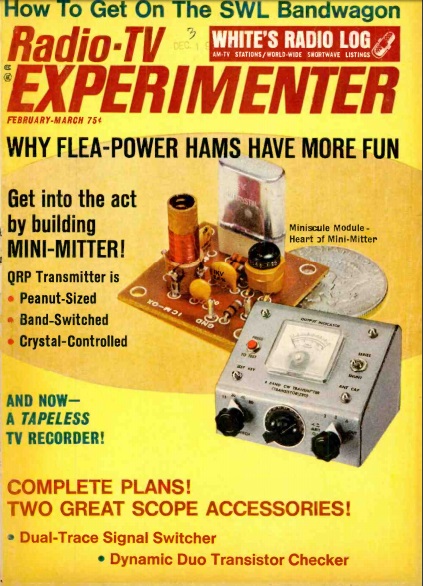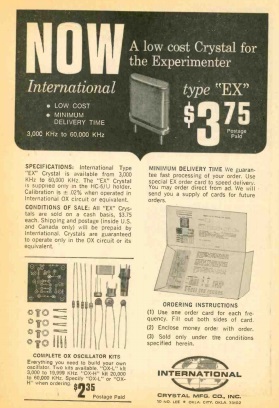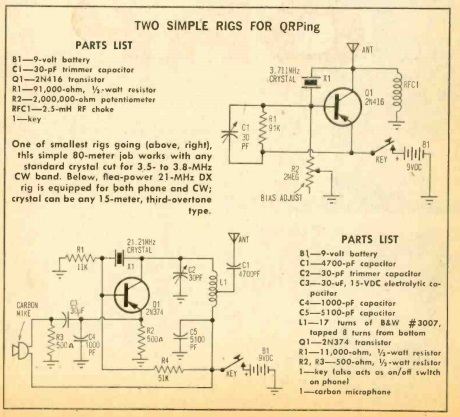 Fifty years ago this month, the January-February 1968 issue of Radio TV Experimenter devoted a considerable number of its pages to Amateur Radio QRP (low power) operation.
Fifty years ago this month, the January-February 1968 issue of Radio TV Experimenter devoted a considerable number of its pages to Amateur Radio QRP (low power) operation.
At the time, “QRP” generally referred to power levels of under 100 watts, but the introductory article by Robert M. Brown, K2ZSQ, revealed that many in what was known in ham circles as “that crazy QRP crowd” were seeing what could be done with flea-power setups, often consisting of a single transistor, IC, or tube. He included these diagrams of minimalist one-transistor QRP transmitters:
The cover feature was the “Mini-Mite,” a QRP transmitter designed by Howard Pyle, W7OE. This was a 4-band transmitter for 80, 40, 20, and 15 meters. The author reported that the set ran an input power of 1.2 watts with a 6 volt power supply, or up to 1.8 watts with a 9 volt supply. His best DX was 1100 miles on 15 meters, 600 miles on 20, 300 miles on 40, and a respectable 200 miles on 80.
 The transmitter actually consisted of four transmitters, since it used four of the ubiquitous International Crystal oscillator module kits, and ad for which is shown here from the same magazine. The oscillator cost $2.35, and an additional $3.75 for the necessary crystal. Essentially the oscillators, even though designed for test circuits, were functioning as transmitters, with just a bit of external matching network before the antenna. To switch bands, one transmitter was switched out of the circuit, and one for another band switched in.
The transmitter actually consisted of four transmitters, since it used four of the ubiquitous International Crystal oscillator module kits, and ad for which is shown here from the same magazine. The oscillator cost $2.35, and an additional $3.75 for the necessary crystal. Essentially the oscillators, even though designed for test circuits, were functioning as transmitters, with just a bit of external matching network before the antenna. To switch bands, one transmitter was switched out of the circuit, and one for another band switched in.
It should be noted that it’s likely that none of these 1968 circuits would meet modern spectral purity requirements. Chances are, a bit more external filtering would be required. But the concept shown here is recognizable in many minimalist QRP rigs that are once again in style by “that crazy QRP crowd.”


For several months, I’ve been “noodling over” the existence of the above referenced articles and the magazine within which they were published. The one common thread that I recalled was W7OE (Howard S. Pyle – SK) was the author. Various searches all came to dead ends as I explored numerous rabbit holes. This morning, I decided on a different “Search String” plan and on the second run landed upon the onetuberadio.com web site and this post.
I believe that W7OE may have written another article about the recently developed (at that time) International Crystal Manufacturing (ICM) modules. That article featured a “single” module transmitter, which was single band and less the fancy cabinet and meter, etc. It may also have been published in a different magazine.
I built a couple of the single band versions shortly after reading the initial article. With limited test equipment, my metrics were limited to calculating the Input Power. As W7OE’s QTH was “One State to the North” of me at that time, we exchanged a couple letters regarding “power” calculations. He patiently explained the difference between Input Power and Output Power to me. He did indicate the higher band ICM modules were not nearly as efficient, thus the 10-Meter module “output” would be considerably less than the 80-Meter “output”. (He also suggested the ICM type PAX-1 “RF Amplifier” module to boost the output a tad!)
Over the decades, I would go on to construct several more small QRP rigs using those ICM modules. A couple years ago, I was in the midst of modifying one of my original “Early 70s Vintage” OX/PAX-1 “Rigs” to the 60-Meter Band when ICM went out of business.